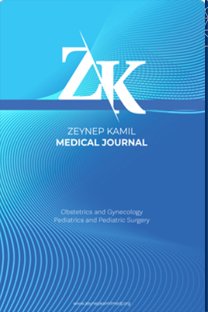PET/CT dilemma in para-aortic lymph node assessment in locally advanced cervical cancer?
PET/CT dilemma in para-aortic lymph node assessment in locally advanced cervical cancer?
___
- 1. Siegel RL, Miller KD, Jemal A. Cancer statistics, 2020. CA Cancer J Clin 2020;70(1):7–30.
- 2. Walboomers JM, Jacobs MV, Manos MM, Bosch FX, Kummer JA, Shah KV, et al. Human papillomavirus is a necessary cause of invasive cervical cancer worldwide. J Pathol 1999;189(1):12–9.
- 3. Ries LA, Melbert D, Krapcho M, Mariotto A, Miller BA, Feuer EJ, et al. SEER Cancer Statistics Review, 1975-2004. Bethesda, MD: National Cancer Institute; 2007.
- 4. Bhatla N, Aoki D, Sharma DN, Sankaranarayanan R. Cancer of the cervix uteri. Int J Gynaecol Obstet 2018;143 Suppl 2:22–36.
- 5. Bhatla N, Berek JS, Cuello Fredes M, Denny LA, Grenman S, Karunaratne K, et al. Revised FIGO staging for carcinoma of the cervix uteri. Int J Gynecol Obstet 2019;145(1):129–35.
- 6. Benedet JL, Bender H, Jones H 3rd, Ngan HY, Pecorelli S. FIGO staging classifications and clinical practice guidelines in the management of gynecologic cancers. FIGO committee on gynecologic oncology. Int J Gynaecol Obstet 2000;70(2):209–62.
- 7. Pecorelli S. Revised FIGO staging for carcinoma of the vulva, cervix, and endometrium. Int J Gynaecol Obstet 2009;105(2):103–4.
- 8. Pecorelli S, Zigliani L, Odicino F. Revised FIGO staging for carcinoma of the cervix. Int J Gynaecol Obstet 2009;105(2):107–8.
- 9. Jemal A, Bray F, Center MM, Ferlay J, Ward E, Forman D. Global cancer statistics. CA Cancer J Clin 2011;61(2):69–90.
- 10. Singh N, Arif S. Histopathologic parameters of prognosis in cervical cancer-a review. Int J Gynecol Cancer 2004;14(5):741–50.
- 11. Brownell GL, Sweet WH. Localization of brain tumors with positron emitters. Nucleonics 1953;11(11):40–5.
- 12. Ramirez PT, Jhingran A, Macapinlac HA, Euscher ED, Munsell MF, Coleman RL, et al. Laparoscopic extraperitoneal para-aortic lymphadenectomy in locally advanced cervical cancer: A prospective correlation of surgical findings with positron emission tomography/computed tomography findings. Cancer 2011;117(9):1928–34.
- 13. Leblanc E, Gauthier H, Querleu D, Ferron G, Zerdoud S, Morice P, et al. Accuracy of 18-fluoro-2-deoxy-D-glucose positron emission tomography in the pretherapeutic detection of occult para-aortic node involvement in patients with a locally advanced cervical carcinoma. Ann Surg Oncol 2011;18(8):2302–9.
- 14. Uzan C, Souadka A, Gouy S, Debaere T, Duclos J, Lumbroso J, et al. Analysis of morbidity and clinical implications of laparoscopic para-aortic lymphadenectomy in a continuous series of 98 patients with advancedstage cervical cancer and negative PET-CT imaging in the para-aortic area. Oncologist 2011;16(7):1021–7.
- 15. Wrenn FR Jr., Good ML, Handler P. The use of positron-emitting radioisotopes for the localization of brain tumors. Science 1951;113(2940):525– 7.
- 16. Pacák J, Cerny M. History of the first synthesis of 2-deoxy-2-fluoro-dglucose the unlabeled forerunner of 2-deoxy-2-[18F]fluoro-D-glucose. Mol Imag Biol 2002;4(5):352–4.
- 17. Bhatla N, Berek JS, Fredes MC, Denny LA, Grenman S, Karunaratne K, et al. Revised FIGO staging for carcinoma of the cervix uteri. Int J Gynaecol Obstet 2019;145(1):129–35.
- 18. Parker K, Gallop-Evans E, Hanna L, Adams M. Five years’ experience treating locally advanced cervical cancer with concurrent chemoradiotherapy and high-dose-rate brachytherapy: Results from a single institution. Int J Radiat Oncol Biol Phys 2009;74(1):140–6.
- 19. Grigsby PW, Siegel BA, Dehdashti F. Lymph node staging by positron emission tomography in patients with carcinoma of the cervix. J Clin Oncol 2001;19(17):3745–9.
- 20. Havrilesky LJ, Kulasingam SL, Matchar DB, Myers ER. FDG-PET for management of cervical and ovarian cancer. Gynecol Oncol 2005;97(1):183–91.
- 21. Gold MA, Tian C, Whitney CW, Rose PG, Lanciano R. Surgical versus radiographic determination of para-aortic lymph node metastases before chemoradiation for locally advanced cervical carcinoma: A gynecologic oncology group study. Cancer 2008;112(9):1954–63.
- 22. Marnitz-Schulze S, Tsunoda A, Martus P, Vieira MV, Affonso R, Nunes JS, et al. UTERUS-11 STUDY: A randomized clinical trial on surgical staging versus ct-staging prior to primary chemoradiation in patients with FIGO2009 stages IIB-IVA cervical cancer. Int J Gynecol Cancer 2019;29(3):A15.
- ISSN: 1300-7971
- Yayın Aralığı: Yılda 4 Sayı
- Yayıncı: Ali Cangül
Semih BOLU, Fatih İŞLEYEN, Ayşegül DANIŞ
Evaluation of the relationship between method of delivery and breastfeeding characteristics
Selcuk UZUNER, Feyza USTABAŞ KAHRAMAN, Beyza MAŞLAK
Acute dystonia after domperidone use: A rare and an unexpected side effect
Salih DEMİRHAN, Özlem ERDEDE, Rabia Gönül SEZER YAMANEL
Bilateral serous macular detachment as a complication of preeclampsia: A case report
Özkan KOCAMIŞ, Emine TEMEL, Kemal ÖRNEK, Nazife Aşıkgarip
PET/CT dilemma in para-aortic lymph node assessment in locally advanced cervical cancer?
Tayup ŞİMŞEK, Selen DOĞAN, Özer BİRGE, Mehmet Sait BAKIR, Hasan Aykut TUNCER, Ceyda KARADAĞ
Hasan Hüseyin MUTLU, Elif YÜKSEL KARATOPRAK, Müferet ERGÜVEN, Nilüfer ÇETİNER
Oncologic breast surgery of retroareolar breast cancer with racquet mammoplasty technique
